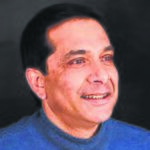Different versions of a past self
It is still too early to tell if this was a mistake or not. A few days back, after a gap of almost 50 years, I went inside a house that we had lived in when I was a child. One had seen it from the outside several times, but this was the first time one had gone in. The opportunity seemed too good to pass. It was between occupants. Apart from some bags that the new occupant had sent ahead, it was quite empty. A visit was very kindly arranged and I was left on my own to wander through rooms that one had once known so well. It was evening and fairly dark. My hand moved instinctively to where one knew the light switches were. Everything seemed the same, and yet different. A couple of new rooms had been added; the service staircase by the kitchen had been removed. The polished or varnished wood had given way to white paint. Apart from a dumbwaiter, the pieces of furniture that had come with the house were gone. Half a century is, after all, a long time. Several people had lived there before us, and several had come after.
Why did I go there? Was it because the opportunity presented itself? That may or may not be. There had been times earlier that one could have done so. Perhaps, it was a moment of weakness, or perhaps of strength that one felt one could deal with the weight of memory that those rooms carried. Not quite, but this was vaguely similar to my relatives of the post-Partition generation who had had occasions to visit their old homes across the border. Many, like my father, chose not to. For my father, the answer was, as usual, direct and simple: “That time is over. I have many happy memories and I would like those to remain as they are.” Another relative widened the scope of explanation: “We are Punjabis and we live in the moment. We don’t dwell too much in the past.” As some of my dyed-in-the-wool brethren would say in Punjabi: “Agge chal kaka.” Move on.
When we were in the house that I had re-entered, one of the rooms had served both as a passage and as my bedroom. Apart from a desk and bed, in that little area was a small glass-fronted cupboard. That had held my comic books — piles of ‘Dennis, the Menace’, ‘Archies’, ‘Commandos’, Classics Illustrated, and copies of ‘Amar Chitra Katha’. That also had Enid Blyton’s ‘Famous Five’ and WE Johns’ ‘Biggles’. These are what we grew up reading. One did not even think of it at that time, but now, there is something that one could well call the ‘Enid Blyton syndrome’. This is not quite the ‘Stockholm syndrome’ where a victim identifies with, and may even sympathise with the abuser or captor. In many of the children’s books that I’ve mentioned, there was often a dark-skinned native who would loyally come to help the whites. We dark-skinned readers did not identify ourselves with the native boy, but instead we attached ourselves with the whites in the story. They were the protagonists and they were the heroes. How could we even imagine that we fell in the same category as the skinny boy who ran around in a loincloth, travelled on an elephant and looked after snakes in his spare time? We had transferred our identity to something that did not and never had existed for us.
As years went on, along came a conscious desire to disconnect with that illusionary identity — but without forsaking the influence it had held. Trying to de-colonise oneself, if you will — but all the while remembering the delight, the thrill that those pages had given. It’s a tricky call with a fair measure of moral ambiguity.
Not just this moment, but why do we visit places that we have known? Some that have held happiness and some that have been otherwise. Is it to relive moments or is it to try and put ghosts of the past to rest? All along our lives, we live different versions of ourselves. An arm that stretches from childhood — the prototype in flesh and blood that sets out into the world — goes past youth into adulthood, may not even recognise the end product of a lifetime. Or even an interim one.
Standing at the entrance of that house, I turned back once more to look at the drawing room. None of the furnishings was same. Had I looked at myself of today from the eyes of that young boy who had once lived there, I would not have been able to recognise myself. For that matter, at any time of our lives, are we ever the same, between one day and the next, between one daily challenge or inspiration and another? Is the ‘self’ continuous — and does it even matter? Are we the same person that set out all those years ago? Unlikely. Are we what we are simply because of where we are?
And then, there was an incongruous reminder of the time we had lived there. On the thick beam of a door-head were two small marks. These were the leftovers of hooks that had been set there, years and years ago, to hold a swing for my sister.
— The writer is an author based in Shimla









